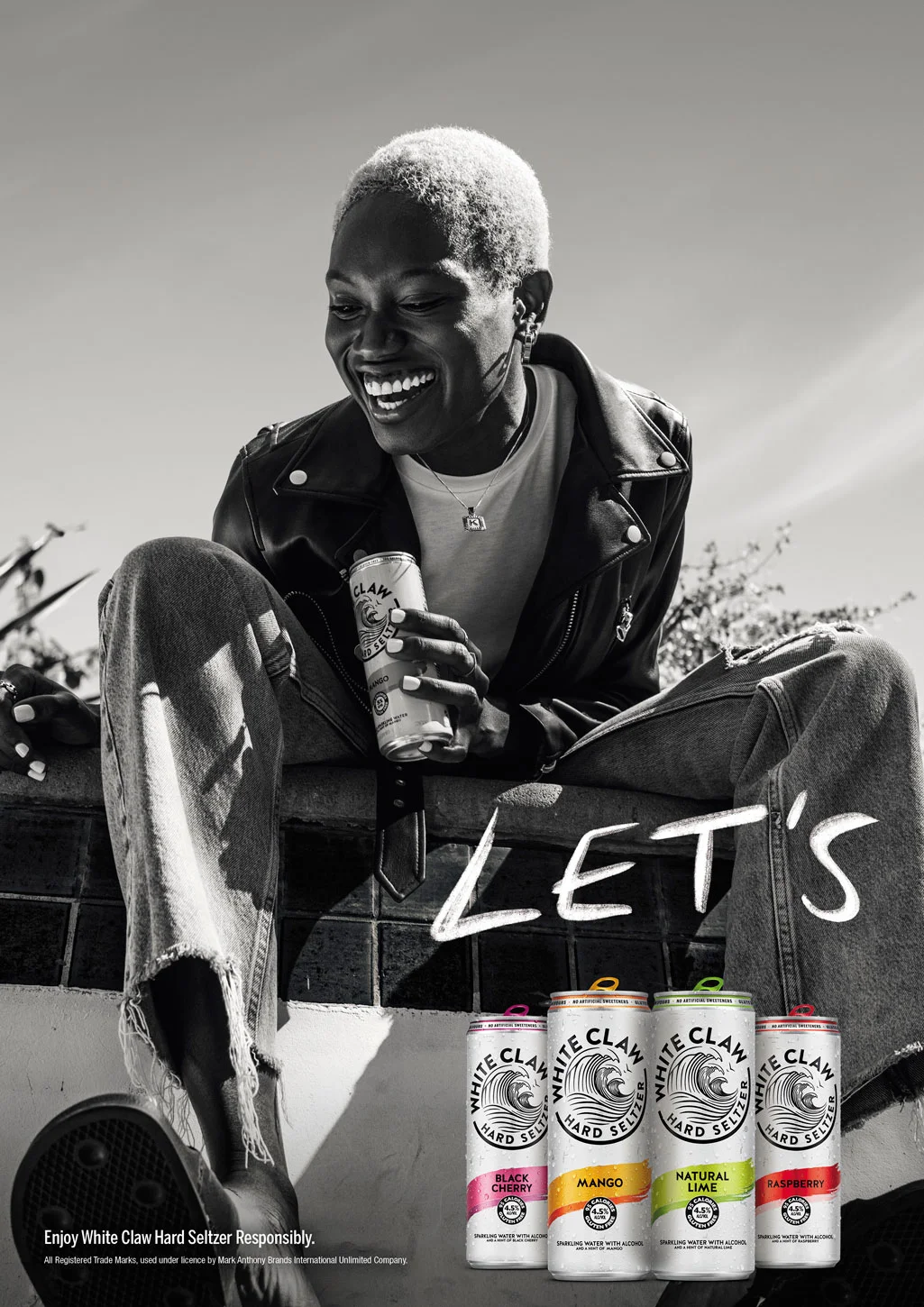White Claw Marketing Strategy: Hard Seltzer Brand Growth
White Claw takes a gender-neutral stance and not assuming what their customers want. They implement this successfully in all of its marketing initiatives. They market their goods to both male and female customers.
Due to the growth of hard seltzer, the US beer market has lost market share. The market for hard seltzer is expanding astronomically, driving consumers away from other alcoholic beverages. For the next five years, the ready-to-drink beverage sector anticipates growth at the quickest rate in the U.S.. This is driven by hard seltzer and other products that resemble it.
Market Trends
A highball beverage known as hard seltzer has carbonated water, alcohol, and frequently fruit flavoring. This beverage has become incredibly popular in recent years. The product itself has drawn a wide range of buyers. It has reaches the market at just the appropriate time. Hard seltzer is equally appealing to both sexes. It is most popular among Caucasians between the ages of 21 and 44 from wealthy neighborhoods, according to Nielsen.
The growth of the enormous wellness sector shows that people are giving their lifestyles more importance. It’s indisputable that the hard seltzer industry is at its best right now. Beverages are low in calories, hydrating, and has an ABV similar to most light beers. This trend also appeals to casual drinkers who don’t like strong alcohol. They want beverages with a lower ABV, beer users who want something new, spirits fans who want something lighter, and beer drinkers who want something different.
The Strategy Behind the Brand
White Claw is the often choice for consumption since its introduction in May 2016. Anthony von Mandl, the company’s originator, is now a rock star in the spirits industry thanks to its success. He made a fortune with Mike’s Hard Lemonade before starting White Claw. He also owns some of the top wineries in the world. Prince William and Kate Middleton visited his wineries in British Columbia in 2016. Many media sites have branded Von Mandl “Tony Baloney”. The cause is his talent for using gripping tales to promote his goods.
After its release, White Claw hard seltzer has gained such an insane following. In September 2019, during the “Summer of White Claw,” Trevor Wallace uploaded a YouTube video. It amassed 6 million views and the company experienced a scarcity. The beverage “hit a chord with the zeitgeist of American drinkers as it sits at the confluence of health, wellbeing, and convenience,” according to numerous memes since it’s popularity. Sales of White Claw exceeded $2 billion in 2021. The business still receives recognition as producing the “best hard seltzer.”
The beverages mix the ease of seltzer water with a base of alcohol-free of gluten. And a smidge of fruit flavor. The fermented sugar used to make the alcohol is made from malted, gluten-free grains. With a 360-degree strategy that extends its reach beyond the brand’s digital platforms into traditional media and retail, the company’s marketing objectives center on increasing consumer awareness, engagement, and enthusiasm. For Millennial tastes, an entire category of hard seltzer exists. Without a doubt, White Claw dominates pop culture and is the most popular hard seltzer branding agency worldwide.
Trends Driving White Claw’s Growth
Wellness: Understanding Lifestyles
Wellness now encompasses much more than just physical health, exercise, and diet in recent years. It is a broad concept that includes one’s mental, emotional, and social well-being. Corporations are changing their values to fit this trend. Consumers are adopting a personal sense of holistic well-being as a result of the emergence of wellness culture. On social media, brands are promoting “aspirational lifestyles.” Millennials are the first generation to understand and embrace the wellness attitude. Three of the largest trends in the health and wellness business are by millennials in innovative ways.
A healthy, balanced lifestyle is vital to 77% of respondents, according to the Natural Marketing Institute (NMI). Customers are looking for options that are “better for me.” Yet what “better for me” actually means is up for debate. White Claw has tapped into this trend by creating products that are inherently gluten-free, just 70–100 calories, 3.7% alcohol, and 0 grams of carbs. Consumers can purchase goods packaged in a 12-ounce can with several fruit flavors to choose from.
Taste: Listening To Fans
It’s crucial to listen to your target audience. The company adopts these flavors after consulting 70,000 social media requests from its Internet users. It might be really beneficial to pay attention to the preferences of your followers who get in touch with you. For White Claw, word-of-mouth advertising has been the most effective marketing tool. White Claw comes in twelve different flavors and is available in a variety of containers, including cans, jars, and others. It sells six 12-can bundles and individual beverages so that consumers can sample all of the company’s varieties.
White Claw hard seltzer Surge, a bolder refreshing wave with 8% alcohol, and White Claw hard seltzer Variety Pack Flavor Collection No. 3 are two new inventions by the brand a couple years ago. Variety packs are crucial for hard seltzer, according to Danelle Kosmal, Vice President of Nielsen’s beverage alcohol business. They represent almost all brands’ best-selling flavor packs and 63% of Hard Seltzer’s overall sales.
Increase in Market Demand
Only three years ago, a shortage in the US soars the sales of the popular hard seltzer White Claw. To the point where young adults wanting to get the trendy beverage start panic buying. Although it was often that hard seltzer was only a summertime beverage and hence susceptible to seasonal product fluctuations, the category is durable. Nonetheless, the growing popularity of hard seltzer offers both new potential and difficulties.
There are numerous explanations for why hard seltzer is so popular. In contrast to other alcoholic beverages, seltzer is thought to be healthier. All of these explanations for customer preferences help to create a market that draws traders from all fields and specialties. Product demand is being driven by the younger generation’s rising acceptance of low-alcohol beverages. Also, people are attempting to consume less alcohol or go sober. This increases demand for beverages with low alcohol content.
Embracing Gender Norms
Companies are discovering that it is impossible to disregard the changing gender conventions. They adopt a gender-neutral strategy rather than assuming what its customers want depending on their gender. White Claw has been so effective in all of its marketing initiatives. Their merchandise markets to both male and female customers. More than any previous generation before, millennials and Gen Z do not view gender as a barrier or guardrail to their socialization. They want to do the same things and spend time together.
White Claw, with the slogan “Made Pure,” is more like premium sparkling water than a beer and takes its name from the expression for a breaking wave. “It wasn’t about following what the beer business is currently doing,” according to Zara Flynn, marketing partner at the advertising agency Rothco. “It was about defying those conventions and coming up with something wholly original and new. Because it’s intention is for everyone and no one, White Claw was able to be successful. It’s a welcoming approach to enjoying your friends’ company (the experience).”
Income InEquality: Pricing
White Claw and other companies in the sector have grown in popularity while maintaining a competitive price. They have developed into a “lifestyle brand.” They emphasize social interactions with friends over financial possessions and constructing experiences around the product itself. The target market for hard seltzer is the millennial generation. Millenials value experiences over status symbols due to growing expenses and stagnant wages. Hard Seltzer has embraced this concept by sparing no expense in fusing the product with opulent activities like windsurfing, sailing, hiking, etc.
Viral Marketing
The total amount spent on hard beverages jumped 39% from the previous year. Spending on digital media has increased the most, by 63%. Between January and October 2021, hard soda businesses spent $41.8 million on digital advertising. TV is still by far the most popular channel for this category. Even though consumers have turned to digital advertising more than any other category. Brands spent around $194.5 million on TV, a 35% increase from the prior year. Spending on print media increased as well. Investments went from $541, 000 to $649, 000, a 20% increase.
White Claw has always been quite picky when it comes to ad placement. Kantar Media estimates that the brand spent about $20,397,502 on media. Broadcast advertising accounts for 89.14% of the budget tracked. Out-of-home advertising acounts for 5.98%, digital display advertising for 4.86%, and print advertising for 0.02%. White Claw invests a significant portion of its advertising budget on Instagram, Facebook, and Twitter. However, Kantar does not account for this spending.
After all, the most effective marketing tactic is word of mouth. In the summer of 2019, one of PR’s breakthroughs occurred. There are no laws when you drink claws, according to a video published by Trevor Wallace. After then, the brand established itself as America’s unofficial party beverage, generating a significant amount of online publicity. Even law enforcement agencies felt the need to inform the public that laws do apply while consuming White Claw. The company’s strategy focused mostly on defining the brand and educating people about it.
Things Brands Need To Consider
Brands must be open and conscious of shifting social standards. Not many brands have a marketing plan for a certain gender of customers.
Being first provides you an advantage over your rivals, but it does not make the competition that follows you irrelevant.
Companies must be crystal clear about their mission and consistently remind their audience of it while also remembering their fears.
Be creative. Our ability to reach consumers in new ways thanks to technology has a direct impact on how product design happens. Accept this change, and instead of seeing technology as a hindrance, discover ways to use it to your advantage.
Will White Claw lose market share to the newcomers? Being the first to market in consumers’ eyes is a tremendously effective marketing technique. But there is growing competition from new entrants. The market expects to rise by triple digits this year due to rising consumer demand expanded brand availability, and new product introductions. Although it is unclear, we are optimistic that White Claw will continue to be a major force in the hard seltzer industry.




